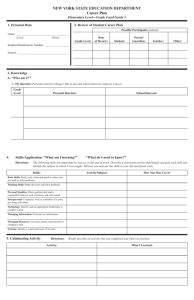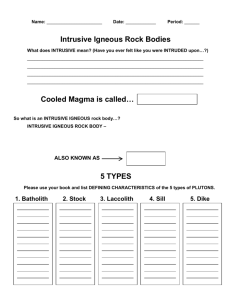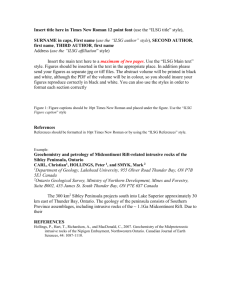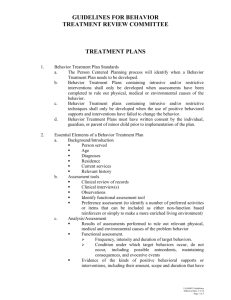Psychological and Interpersonal Implications of Peer Interactions on
advertisement
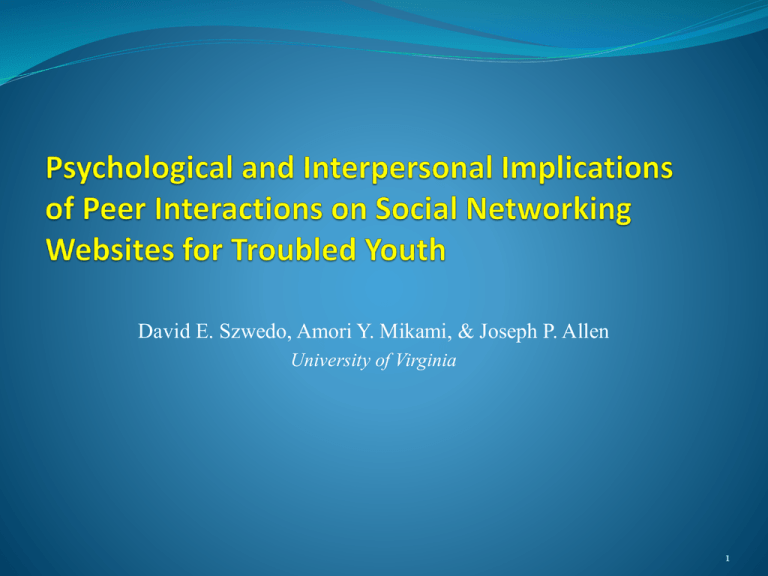
David E. Szwedo, Amori Y. Mikami, & Joseph P. Allen University of Virginia 1 • Current state of Internet use, online social communication, and social networking websites • Observational social networking website coding methodology • Review theory and findings between online social communication and: - Internalizing symptoms - Externalizing behavior - Friendships 2 • Examine associations between youths’ observed online behavior and future: - Depressive symptoms - Intrusive behavior - Friendship competence • Consider the significance of youths’ initial offline psychosocial functioning for predicting these future outcomes 3 • 93% of adolescents (ages 13-17) are currently online5 - 77% of 15-17 year-olds use social networking websites6 - 75% of 18-24 year-olds use social networking websites6 • Daily communication with friends6: - 42% send messages through social networking websites - 26% send instant messages - 16% send email - 29% spend time with friends in person outside of school 4 5 6 7 • Teens and adults use social networks to make and maintain friendships6: • Stay in touch with friends: - 91% of teens and 89% of adults • Make plans with friends: - 72% of teens and 57% of adults • Make new friends: - 49% of teens and 49% of adults 8 Sample • 63 young adults • Drawn from larger study of adolescents, their parents, and friends • 25 males / 38 females • Assessed at ages 20 & 21 • Socio-economically diverse (median family income: $40-$60K) • 67% Caucasian; 22% African-American; 11% other/mixed ethnicity 9 • “Friended” participants to gain access to personal profile • Or viewed participants’ profiles in the public domain • Examined: • Size of online friend network • Quality of comments received from peers • Quality of photos posted on profile 10 Number of Friends – Total number of online “friends” in youths’ online social network Number of Different Friends Posting – How many different people leave messages on youths’ wall 11 Deviant Talk Comments – Comments reflecting profanity, indirect or direct mention of alcohol or drug use, delinquency, or sex Deviant Behavior in Posted Photos – Examples include explicit alcohol use (e.g. taking shots, doing kegstands), provocative dress or gestures, or vandalism 12 Depressive Symptoms Beck Depression Inventory Self-report Intrusive Behavior Adult Behavior Checklist Close-peer report Close Friendship Competence Self-Perception Profile for Adolescents Close-peer report 13 • Early studies suggested a positive relationship between Internet use and depressive symptoms1,2 • Suggested that time spent online may take time away from face-to-face social relationships1,3 • Some early evidence indicated that these effects may disappear as Internet use becomes more normative4 14 • More recent forms of online social communication may be associated with lower depressive symptoms • - May be easier for youth with offline difficulties to communicate • online • Associations may depend on initial levels of youths’ offline psychosocial functioning7,8,9,10 • Positive interactions may help less well-adjusted youth whereas negative interactions may exacerbate problems of less well-adjusted youth 15 • Regression 1. Gender Family income 2. Time 1 offline psychosocial functioning 3. Time 1 social-networking website behavior 4. Time 1 offline psychosocial functioning X Time 1 social-networking website behavior • Outcomes (Time 2) • Depressive symptoms • Intrusive behavior • Friendship competence 16 Change in Depressive Symptoms 1.8 1.6 -.34* 1.4 1.2 1 High Depression 0.8 Low Depression 0.6 0.4 0.2 .02 0 -0.2 Low High Number of Friends 17 Change in Depressive Symptoms 2.5 2 -.43** 1.5 High Depression Low Depression 1 .12 0.5 0 Low High Number of Different People Posting Positive Qualities linked to Decreased Symptoms for Youth who began the study more Depressed 18 Change in Depressive Symptoms 2.5 2 .58** 1.5 High Depression 1 Low Depression 0.5 -.19 0 -0.5 Low High Deviant Behavior in Photos Deviant Photos linked to Increased Symptoms for Youth who began the study more Depressed 19 • For youth with greater Depressive Symptoms: • Positive online qualities predict decreased Depression • Negative online qualities predict increased Depression 20 • Online friend network size → fewer deviant comments from peers • Offline literature: Positive friendships may reduce externalizing behavior Expect similar results for positive online relationships 21 • Offline delinquency → later hostility online • Offline delinquency → deviant behavior in posted photos online • Online deviant comments/photos → increased offline alcohol use Negative online behavior may increase offline externalizing behavior Less well-adjusted youth may be more influenced 22 Change in Intrusive Behavior 1.2 1 0.8 -.49** 0.6 0.4 High Intrusive Behavior 0.2 Low Intrusive Behavior 0 -0.2 .31* -0.4 -0.6 -0.8 Low High Number of Friends Positive Qualities linked to Decreased Intrusive Behavior for Youth who began the study more Intrusive 23 Change in Intrusive Behavior 0.6 0.4 0.2 .35* 0 -0.2 High Intrusive Behavior -0.4 Low Intrusive Behavior -0.6 -.15 -0.8 -1 Low High Number of Deviant Talk Comments Deviant Comments linked to Increased Intrusive Behavior for Youth who began the study more Intrusive 24 • For youth with greater Intrusiveness: • Positive online qualities predict decreased Intrusiveness • Negative online qualities predict increased Intrusiveness 25 • Initially thought that Internet use might reduce social relationships • Online communication not as satisfying as face-to-face • Recent evidence: Social networking websites may stimulate friendships Online relationships may be as satisfying as offline 26 • Youth who are more socially skilled offline: • - More online friends • - More connection online from friends • - More support online from friends Will better adjusted youth who engage in positive online communication be seen as more competent friends? Will poorly adjusted youth who engage in negative online communication be seen as less competent friends? 27 Will better adjusted youth who engage in positive online communication be seen as more competent friends? • Examine interactions: Positive Online Behavior X Depressive Symptoms Positive Online Behavior X Intrusive Behavior 28 Change in Friendship Competence 5.5 .38* High Depression 4.5 Low Depression -.40 3.5 Low High Number of Friends More Friends linked to Increased Competence for Youth who began the study less Depressed 29 Change in Friendship Competence 6 5.8 5.6 5.4 .45** 5.2 High Intrusive Behavior 5 4.8 Low Intrusive Behavior -.16 4.6 4.4 4.2 4 Low High Number of Different People Posting More People Posting linked to Increased Competence for Youth who began the study less Intrusive 30 Will poorly adjusted youth who engage in negative online communication be seen as less competent friends? • Examine interactions: Negative Online Behavior X Depressive Symptoms Negative Online Behavior X Intrusive Behavior 31 Change in Friendship Competence 6 5.8 5.6 .21 5.4 5.2 High Intrusive Behavior 5 4.8 -.60** Low Intrusive Behavior 4.6 4.4 4.2 4 Low High Number of Deviant Talk Comments More Deviant Comments linked to Decreased Competence for Youth who began the study more Intrusive 32 • Predicting Depressive Symptoms & Intrusive Behavior: • Positive and negative qualities of social networking website communication appear to be more important for highly-depressed and highly-intrusive youth • Positive qualities may decrease symptoms • Negative qualities may increase symptoms 33 • Depressive Symptoms & Friendship Competence: Less depressed → positive qualities → more competent • Intrusive Behavior & Friendship Competence: Less intrusive → positive qualities → more competent More intrusive → negative qualities → less competent 34 • Depressive Symptoms & Friendship Competence: Less depressed → positive qualities → more competent • Intrusive Behavior & Friendship Competence: Less intrusive → positive qualities → more competent More intrusive → negative qualities → less competent 35 • Depressive Symptoms & Friendship Competence: Less depressed → positive qualities → more competent • Intrusive Behavior & Friendship Competence: Less intrusive → positive qualities → more competent More intrusive → negative qualities → less competent 36 • Non-experimental nature of the data • Examining a limited number of online behaviors and psychosocial outcomes • Gender differences 37 • Online social-networking behavior may have implications for youths’ offline behavior • These implications may depend on both the quality of youths’ online social behavior and their initial levels of offline psychosocial functioning Copies of this and related papers available at: www.TeenResearch.org 38 • Online communication may provide opportunities for less well-adjusted youth to feel connected to others • However, it may also provide opportunities to exacerbate pre-existing problems Copies of this and related papers available at: www.TeenResearch.org 39 Collaborators Joseph P. Allen, Ph.D. Amori Yee Mikami, Ph.D. Nell Manning Amanda Hare Emily Marston Erin Miga Joanna Chango Megan Schad Claire Stephenson Jen Heliste Amanda LeTard Social Networking Website Coders Meredyth Evans Katy Higgins Maggie Poandl Jessica Van Atta Anne Dawson April Reeves Caroline White Kelly McVicar Copies of this and related papers available at: www.TeenResearch.org 40 1 Kraut, R., Patterson, M., Lundmark, V. Kiesler, S., Mukopadhyay, T., & Scherlis, W. (1998). Internet paradox: A social technology that reduces social involvement and psychological well-being? American Psychologist, 53, 1017-1031. 2 Ybarra, M.L, Alexander, C., & Mitchell, K.J. (2005). Depressive symptomology, youth Internet use, and online interactions: A national survey. Journal of Adolescent Health, 36, 9-18. 3 Cummings, J.N., Butler, B., & Kraut, R. (2002). The quality of online social relationships. Communications of the ACM, 45, 103-108. 4 Kraut, R., Kiesler, S., Boneva, B., Cummings, J., Helgeson, V,. & Crawford, A. (2002). Internet paradox revisited. Journal of Social Issues, 58, 49-74. 5 Jones, S., & Fox, S. (2009). Generations online in 2009. PEW Internet and American Life Project. Retrieved Jan. 3, 2010, from http://www.pewinternet.org/Reports/2009/Generations-Online-in-2009.aspx?r=1. 6 Lenhart, A. (2009). It’s personal: Similarities and differences in online social network use between teens and adults. PEW Internet and American Life Project. Retrieved Jan. 3, 2010, from http://www.slideshare.net/PewInternet/its-personal-similarities-and-differences-inonline-social-network-use-between-teens-and-adults?type=presentation. 7 Ellison, N.B., Steinfield, C., & Lampe, C. (2007). The benefits of Facebook “friends:” Social capital and college students’ use of online social network sites. Journal of Computer-Mediated Communication. 12, 1143-1168. 8 Bessière, K., Kiesler, S., Kraut, R., & Boneva, B. (2008). Effects of Internet use and social resources on changes in depression. Information, Communication & Society, 11(1), 47-70. 9 Ando, R., & Sakamoto, A. (2008). The effect of cyber-friends on loneliness and social anxiety: Differences between high and low selfevaluated physical attractiveness groups. Computers in Human Behavior, 24, 993-1009. 10 Szwedo, D.E., Mikami, A.Y., & Allen, J.P. (2009). Social networking site use predicts changes in youths’ psychological adjustment. Manuscript submitted for publication. Copies of this and related papers available at: www.TeenResearch.org 41

